Sony Cyber-shot DSC-R1Sony "breaks the mold" with a unique SLR/all-in-one hybrid design.<<Video, Power, and Software :(Previous) | (Next): Reference: Datasheet>> Page 13:Test Results and ConclusionReview First Posted: 09/20/2005, Updated: 11/18/2005 |
We ran the Sony R1 through our usual battery of tests, and have summarized our findings here. To see the full set of our test images, with explanations of what to look for in them, see the Sony Cyber-shot R1 Sample Pictures page. For a complete listing of all our test and "gallery" shots, go to the Thumbnails page.
A collection of more random, pictorial images can be found in the Sony Cyber-shot R1 Photo Gallery.
Not sure which camera to buy? Let your eyes be the ultimate judge! Visit our Comparometer(tm) to compare images from the Sony R1 with those from other cameras you may be considering. The proof is in the pictures, so let your own eyes decide which you like best!
Lens
Zoom
A good 5x optical zoom range, with good performance.
|
24mm
|
120mm
|
Digital Zoom
|
The Sony R1 zooms over the equivalent of a 24-120mm range, a range that's a bit larger than average, and one that reaches much wider than that of most cameras on the market. Details are slightly soft at wide angle, though definition is still pretty good. The R1 offers both Smart and Precision Digital Zoom, which effectively take magnification to 15x, albeit with the loss of quality that digital zoom invariably produces. Though details are clearly softer with the digital zoom, there's still quite a bit of fine detail here, but only because the R1 started out with a very crisp 10 megapixels.
Macro
A slightly larger than average macro area with good detail and high resolution. Flash coverage is fairly even, but the shot was underexposed slightly.
| Standard Macro | Macro with Flash |
The Cyber-shot R1's macro setting performs well, though it captures a slightly large minimum area of 3.83 x 2.55 inches (97 x 65 millimeters). Detail is strong and resolution high, though details are slightly soft overall. On the other hand, there's very little additional softening in the corners from the lens. (Most cameras have some softening in the corners in macro mode, the R1 does much better than most in this respect.) The flash throttled down very well for the macro shot, though it underexposed the shot slightly (possibly due to the glare from the brooch).
Distortion
Very low barrel and pincushion distortion.
This is the tendency for the lens to bend straight lines outward (like a barrel--usually at wide angle) or inward (like a pincushion--usually at telephoto). The Cyber-shot R1's 0.2% barrel distortion at wide angle is very low, as is its 0.03% pincushion at telephoto. (Quite a few cameras show very low distortion at telephoto focal lengths, but it's almost unheard of to find barrel distortion this low at a lens' wide angle setting, let alone in a lens that goes as wide as that of the Sony R1.)
| Barrel distortion at 24mm is 0.2% |
| Pincushion at 120mm is 0.03% |
Chromatic aberration
Moderate overall, with small effect on images, though pixels are somewhat bright at wide angle.
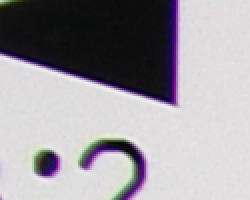 |
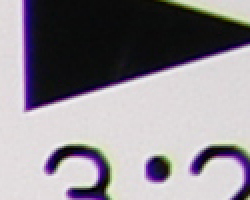 |
| Wide: moderate, top left @ 200% | Wide: fairly bright, top right @ 200% |
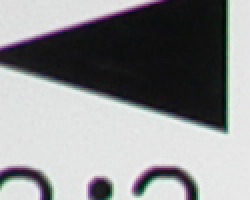 |
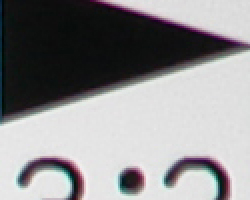 |
| Tele: very low, top left @200% | Tele: very low, top right @200% |
Chromatic aberration is moderate at wide angle and very low at telephoto lens settings. (This distortion is visible as a very slight colored fringe around the objects at the edges of the field of view on the resolution target.) At wide angle, the colored fringes are quite bright, albeit limited in their extent. At telephoto, there's very little coloration at all.
Corner Sharpness
Much less softening in the corners of the frame than we normally see.
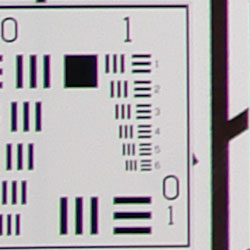 |
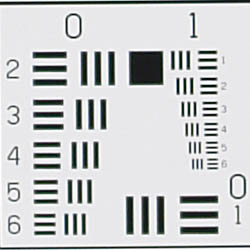 |
| Wide Angle: Just slightly soft in the lower left corner. |
Wide Angle: Center sharpness, for comparison |
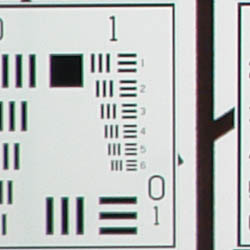 |
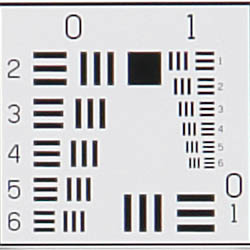 |
| Telephoto: Again, slightly soft in the lower left. |
Telephoto: Center sharpness, for comparison |
The Cyber-shot R1 produced pretty consistent sharpness from corner to corner. Details were just slightly soft in the lefthand corners. The worst case was in the lower left, but even that was much better than we're accustomed to seeing in the cameras we test. Overall, the Sony R1's optical performance was quite a bit better than average, even among high-end prosumer cameras, and also significantly exceeded the performance of lenses typically bundled in "starter kits" with digital SLRs.
Sensor
Exposure and White Balance
Indoors, incandescent lighting
Problems with auto white balance, marginal with Incandescent, but good results with the Manual white balance setting. More exposure compensation required than usual.
| Auto White Balance +1.3 EV | Incandescent WB +1.3 EV |
| Manual White Balance +1.3 EV |
Color balance indoors under incandescent lighting looked best with the Manual white balance, as the Auto setting was quite warm and orange-colored, and the Incandescent setting just a little too yellow for our tastes. The Cyber-shot R1 required a +1.3 EV exposure compensation boost to get a good exposure, a bit higher than average on this shot. Overall color looks pretty good, though the blue flowers are slightly dark and purplish, and Marti's skin tone a little pink. (A very common outcome for this shot.) Our test lighting for this shot is a mixture of 60 and 100 watt household incandescent bulbs, a pretty yellow light source, but a very common one in typical home settings here in the US.
Outdoors, daylight
Pretty good color balance with bright colors. Better than average exposure accuracy.
Outdoor shots generally showed accurate exposure with a slight tendency to lose highlight detail under contrasty lighting. Shadow detail was pretty good, if a little noisy. Exposure accuracy overall was better than average, even under the harsh lighting of the "Sunlit" Portrait, as the camera required a little less positive exposure compensation than we're accustomed to seeing.
See full set of test images with explanations
See thumbnails of all test and gallery images
Resolution
Very high resolution, 1,600 - 1,700 lines of strong detail.
Our laboratory resolution chart revealed sharp, distinct line patterns down to about 1,600 lines per picture height vertically, and 1,700 lines horizontally, with extinction out past 2,000. (The camera did produce slight color artifacts at lower line frequencies though, visible in the full-sized res target shots.) Use these numbers to compare with other cameras of similar resolution, or use them to see just what higher resolution can mean in terms of potential detail. Beware that while you might be able to make out what looks like distinct lines at numbers higher than those we've mentioned here, the camera is just doing its best to continue interpreting the lines, and what you're actually seeing are artifacts, not the original lines of the test target.
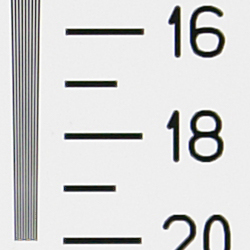 |
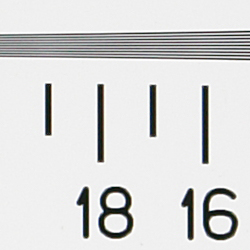 |
| Strong detail to 1,700 lines horizontal | Strong detail to 1,600 lines vertical |
See full set of test images with explanations
See thumbnails of all test and gallery images
Sharpness & Detail
Lots of detail, but the default in-camera sharpening coarsens fine details. Slight blurring of subtle detail from noise suppression.
The Cyber-shot R1's images show a lot of detail, although the camera's internal sharpening overdoes things a bit, coarsening fine detail somewhat. (Edge enhancement creates the illusion of sharpness by enhancing colors and tones right at the edge of a rapid transition in color or tone.) This results in images that are a little soft-looking right out of the camera, but that print fairly well at modest sizes on inkjet printers. Sharpening the images in Photoshop(tm) or other imaging software does reveal a good bit of additional detail, but is limited by the artifacts left by the in-camera sharpening in the first place. Fortunately, the R1 produces almost perfect edges if you set its sharpening adjustment to the Low setting. Images shot this way take unsharp masking very well indeed.
Noise-suppression systems in digital cameras tend to flatten-out detail in areas of subtle contrast. The effects can often be seen in shots of human hair, where the individual strands are lost and an almost "watercolor" look appears. The Sony R1 does this to some extent, but the overall impact isn't as great as on many cameras we test, at least at low ISO settings. The crop of Marti's hair above shows some noise suppression in darker midtones areas, though brighter, individual strands have better definition.
The real secret to getting incredible detail from the Sony R1 is to shoot with the camera's internal sharpening control on its Low setting, and then apply strong/tight unsharp masking in Photoshop(tm) or other imaging software. The crops above show the difference this makes. With the internal sharpening dialed down, the images get very soft, but the artifacts caused by the camera's sharpening are almost completely eliminated. To compensate for the absence of the camera's sharpening, you need to apply quite a lot of unsharp masking (try 400% or more), but if you keep the radius very small (0.3 pixels, 0.4 at most), the result is very crisp images, with virtually no sharpening artifacts, and exceptional fine detail. (In the images above, note how the R1's default sharpening coarsened the delicate stems on the leaves, and how soft the edges of the leaves appear, particularly when compared with the results of the Photoshop sharpening. - Click on either crop to see the full-size image.)
One slightly odd note: In playing with the R1's color modes, we felt that images shot in the Adobe RGB color space were slightly less sharp than those shot in the normal sRGB color space. A res-target test and examination of the edge profiles in Imatest revealed that there was indeed a slight but consistent difference in the steepness of the edge profiles between the two color spaces, with edges in the normal sRGB color space being somewhat sharper. The difference isn't dramatic, but we thought it worthwhile to mention, in case any readers noticed this phenomena themselves. It's real, but a fairly subtle effect.
8-, 10-, and 12-megapixel comparison
We thought it might be interesting to compare images from some conventional d-SLRs with those from the Sony R1, just to see what the differences between 8, 10, and 12 megapixels look like. We didn't have an inexpensive 8-megapixel camera on hand when we were testing the R1 (a Canon Digital Rebel XT or Olympus eVolt E-500), so the cameras we had available to compare with the R1 were both models that sell for much more than the R1 does. Still, the comparison is interesting because it shows that, more than pure pixel count, the post-capture processing performed by the camera or on a computer has a great deal to do with the final image quality.
For this comparison, we shot a complex piece of embroidery work with the Sony DSC-R1, a Canon EOS-20D, and a Nikon D2x. For control purposes, we inserted a small resolution target in the lower left-hand corner of the embroidery piece, to help guide our decision making when it came time to apply unsharp masking to the images. The embroidery work made an excellent subject, because it had a range of detail as well as areas of very subtle contrast between detail elements. This last provided great places to look for the effect of each camera's noise-reduction processing.
We shot the test images with the best optics we had available for each platform. In the case of the D2x, this was a Nikkor 105mm f/2.8 macro lens, and for the 20D, it was the equivalent Canon lens, a 100mm f/2.8 macro. For the R1, we set its lens to the focal length and aperture that our lens testing had shown to produce the sharpest results.
In the interest of time, we kept things simple, working from JPEGs, to avoid questions of which RAW converter and which processing methodology would extract the most detail from each camera's RAW files. - This isn't meant to be any sort of a definitive "shootout" between the three cameras involved, as I don't think anyone would seriously be trying to choose between an R1 and a D2x. The purpose of the exercise was to simply get an idea of the R1's image quality, and see how well it held up against cameras that are to one extent or another standard points of reference in the digital photo world.
For each camera, we shot two images, one using its default setting for in-camera sharpening, the other with its sharpening set to its lowest value, to provide the best file for subsequent unsharp masking in Adobe Photoshop(tm). The sharpening parameters were hand-tweaked for each camera, to produce the crispest-looking image, stopping short of the point at which sharpening artifacts would appear. Here are the results:
| Detail comparison: Images as-shot, default sharpening | ||
| EOS-20D | DSC-R1 | D2x |
 |
 |
 |
 |
 |
 |
| 20D (usm 280%, 0.25 pixel radius) |
R1 (usm 400%, 0.3 pixel radius) |
20D (usm 490%, 0.3 pixel radius) |
| Low sharpening, unsharp masking in Photoshop | ||
Right away, before the Canon fans jump on us for not using as much unsharp masking on the 20D's image, we need to underscore that we gave each image as much USM as it could handle, without producing artifacts. In the case of the 20D, if we went any beyond about 280%, we began to see very visible halos around the bars in the small res target patch. (By the way, "default" on the 20D here means Parameter 1.)
In this particular comparison, it's clear that the D2x is the hands-down winner in the resolution derby. Probably no surprise relative to the 20D, as the D2x has 50% more pixels. What we found interesting was both how well the R1 did against its higher-priced competitors, as well as the ways in which it didn't quite measure up. For high-contrast objects, the R1 clearly displays its full 10 megapixels of resolution (provided of course, that you work from unsharpened images and apply unsharp masking in the computer). When dealing with lower-contrast detail though, the R1's noise-suppression algorithms come into play, flattening-out the detail. You can see this in various places, but the most obvious is in the light brown threads crossing the stem of the flower, towards the top of the page. It seems that either the R1's sensor/electronics inherently have a bit more noise than those of the 20D and D2x, or a decision was taken to just flatten the noise a bit more to produce cleaner images in areas of flat tint (skies, for example).
While it loses a little detail to noise suppression, the DSC-R1 nevertheless produces excellent pictures with exceptional optical quality at a (relatively) bargain price. Also, it's important to note how far from any rational application the above 1:1 on-screen crops are. This sort of pixel-squinting is an interesting exercise, but bears less correlation with print quality than you might think, at least up to print sizes of 11x14 or higher. (Printed full-frame at 13x19 inches on the Canon i9900 printer here in our studio, these differences in these images were certainly discernible, but it took some squinting, under good light.)
ISO & Noise Performance
Low to moderate noise at the normal sensitivity settings, even at ISO 400, though very high levels at the highest settings.
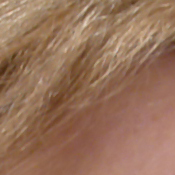 |
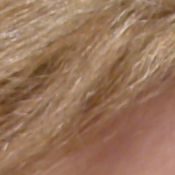 |
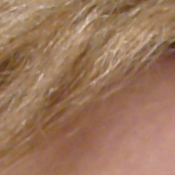 |
| ISO 160 | ISO 200 | ISO 400 |
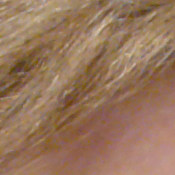 |
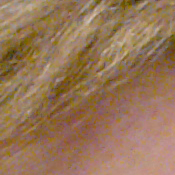 |
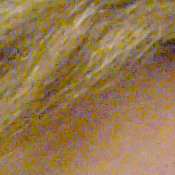 |
| ISO 800 | ISO 1,600 | ISO 3,200 |
The Cyber-shot R1's lower ISO settings produced low noise, with only slightly blurred detail in the darker areas, and even at ISO 400, results were still very good. Noise increased visibly and detail degraded as the ISO increased, from 800 through 3,200. The images at ISO 800 were very usable though, just a little softer than those shot at ISO 400, and even ISO 1,600 images would be fine for many uses. The ISO 3,200 setting was just plain unusable though, for anything other than 4x6 snapshot prints, and even those showed significant color shifts.
Looking at prints from the Sony R1 (which should always be the method by which noise levels are evaluated, if that's intended to be the final output format), ISO 1,600 shots were noisy but probably acceptable when printed at 8x10 inches, but looked entirely fine at 5x7. As noted though, ISO 3,200 shots were noisy but acceptable when printed at 4x6 inches, but had very noticeable color shifts that would lead us to reject them for most uses.
Extremes: Sunlit and low light tests
High resolution with good overall detail, but slightly high contrast. Good low-light performance, capable of capturing bright images under average city street lighting and much darker conditions.
| +0.0 EV | +0.3 EV | +0.7 EV |
Sunlight:
Because digital cameras are more like slide film than negative film (in that they tend to have a more limited tonal range), we test them in the harshest situations to see how they handle scenes with bright highlights and dark shadows, as well as what kind of sensitivity they have in low light. The shot above is designed to mimic the very harsh, contrasty effect of direct noonday sunlight, a very tough challenge for most digital cameras. (You can read details of this test here.)
The Cyber-shot R1 performed pretty well under the deliberately harsh lighting in this test, but contrast was a little high and highlights a bit washed out as a result. (The shots above were captured with the R1's contrast control set to the "low" setting.) Noise suppression is visible in the darker shadows, but shadow detail is still pretty good. The +0.3 EV exposure adjustment left the lower midtones and shadows a bit darker than we'd like, but any higher setting just lost way too much highlight detail. (In "real life", be sure to use fill flash in situations like the one shown above; it's better to shoot in the shade when possible.)
Low light:
The Cyber-shot R1 performed very well here, capturing bright images down to the lowest light level we test at, even at its minimum ISO setting. Color balance was slightly pinkish in a few shots from the Auto white balance setting, but improved at the longer exposure times, and overall was quite good. The camera's autofocus system worked only to just under the 1/2 foot-candle point unassisted, but performed well past 1/16 foot-candle with the AF assist lamp. The camera's noise reduction system worked fairly well, though the higher ISOs (800 - 3,200) showed high noise. Given that city street lighting corresponds to a light level of about one foot-candle (the brightest level we test at), the Sony R1 should do an excellent job with average city night scenes, and subjects a good bit darker.
Color
Saturation & Hue Accuracy
Slightly oversaturated color (especially reds and blues), generally good hue accuracy.
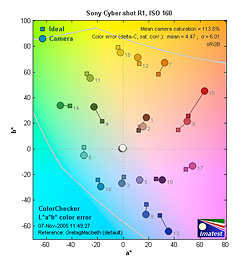 |
| In the diagram above, the squares show the original color, and the circles show the color that the camera captured. More saturated colors are located towards the periphery of the graph. Hue changes as you travel around the center. Thus, hue-accurate, highly saturated colors appear as lines radiating from the center. |
The other important part of color rendition is hue accuracy. Hue is "what color" the color is. Here, the R1 did unusually well. After correcting for the saturation boost, the overall color error of the Sony R1 was among the lowest we've measured.
(For a more in-depth discussion of the Sony DSC-R1's color handling as well as noise levels, dynamic range, and resolution, see the Sony R1 Imatest page.)
Our random "Gallery" shots showed very pleasing color across a wide variety of subjects. (See our Sony Cyber-shot R1 Photo Gallery for more shots taken with the camera.)
Viewfinder
Coverage
Excellent accuracy from the electronic optical viewfinder (EVF).
| 24mm eq., EVF | 120mm eq., EVF |
The Cyber-shot R1's EVF proved quite accurate, showing almost exactly 100% frame accuracy (within the limits of accuracy of this measurement) at both wide angle and telephoto zoom settings.
Flash
Coverage and Range
The R1's flash is fairly bright, though our standard shots required slightly more exposure compensation than average. Range is 14+ feet at ISO 160.
| 24mm equivalent | 120mm equivalent |
| Normal Flash +1.3 EV | Slow-Sync Flash +1.3 EV |
Flash coverage was uneven at wide angle but more uniform at telephoto. In the Indoor test, the R1's flash underexposed our subject at its default setting, requiring a +1.3 EV exposure compensation adjustment to get reasonably bright results. Even here, the exposure is a little dim, with a strong orange cast. The camera's Slow-Sync flash mode produced similar results, though coverage was more even and the orange cast a little stronger. The Slow-Sync mode also required a +1.3 EV exposure compensation adjustment.
| 8 ft | 9 ft | 10 ft | 11 ft | 12 ft | 13 ft | 14 ft |
1/50 sec f4.8 ISO 160 |
1/50 sec f4.8 ISO 160 |
1/50 sec f4.0 ISO 160 |
1/50 sec f4.5 ISO 160 |
1/50 sec f4.5 ISO 160 |
1/50 sec f4.5 ISO 160 |
1/50 sec f4.8 ISO 160 |
The R1's flash illuminated the test target at 14 feet, with good intensity.
Output Quality
Print Quality
Excellent print quality, great color, excellent 13x19 inch prints. ISO 1,600 images are soft but usable at 8x10, excellent at 5x7. ISO 3,200 images are marginal, even at 4x6 inches.
Testing hundreds of digital cameras, we've found that you can only tell just so much about a camera's image quality by viewing its images on-screen. Ultimately, there's no substitute for printing a lot of images and examining them closely. For this reason, we now routinely print sample images from the cameras we test on our Canon i9900 studio printer, and on the Canon iP5000 here in the office. (See the Canon i9900 review for details on that model.)
Prints from the Sony DSC-R1 were just beautiful: Even at 13x19 inches, images were crisp and held together very well. Colors were bright without appearing overdone, and tonality was very good. At a reference print size of 8x10 inches, image noise was essentially up to ISO 400 and barely discernible at ISO 800. At ISO 1,600, the noise became more visible, and the image got a little softer-looking due to the camera's anti-noise processing, but the final results were still eminently acceptable. At ISO 3,200 though, things really fell apart, with ugly noise and a pronounced greenish color shift. ISO 3,200 prints were only marginally acceptable at 4x6 inches, and even there, the color shift would probably consign them to the waste basket. (We really found ourselves wondering why Sony bothered to put an ISO 3,200 setting on the camera.)
Timing and Performance
Sony Cyber-shot R1 Timing
Good to average speed for a prosumer camera, but it still doesn't compare to most digital SLRs.
| Startup/Shutdown: | |
| Power On to first shot | 1.0 second |
| Shutter response (Lag Time): | |
|
Full Autofocus Wide
|
0.76 / 0.48 second
|
|
Full Autofocus Tele
|
0.77 / 0.74 second
|
|
Continuous AF Wide / Tele
|
0.33 / 0.37 second
|
|
Prefocused
|
0.007 second
|
| Cycle time (shot to shot) | |
| Normal large/fine JPEG | 1.66 / 1.27 seconds |
| Flash recycling | 6 seconds |
| Continuous mode | 0.31 second 3.23 frames/second (3 large/fine frames) |
| Download speed | |
| Windows Computer, USB 2.0 | 2,103 KBytes/sec |
While the Sony DSC-R1's performance isn't bad when compared to most "prosumer" digital cameras, many people considering it for purchase will also be considering buying a dSLR. When stacked up against almost any dSLR, the Sony R1's timing performance leaves much to be desired. Its best-case shutter lag of 0.33 second compares favorably with the lower end of the digital SLR market, but in most operating modes, shutter lag is between 0.5 and 0.75 second, definitely slower than its dSLR competition. The "Preview" viewfinder mode does produces somewhat faster shutter response than the "Framing" option (which permits slower refresh rates, to give a brighter viewfinder display in dim lighting), but seemingly only when the lens is set towards the wide angle end of its zoom range: Shutter lag at telephoto focal lengths appears to be unaffected by the Preview/Framing selection, at least at reasonably bright light levels. One bright spot though, is that the camera is noticeably faster when running in continuous focusing ("monitor") mode, where shutter lag drops to only about 0.33 second at wide angle and 0.37 second at telephoto, putting it at least in the same ballpark as most d-SLRs.
At 1.27 seconds (best case) between frames, single-shot cycle times are reasonably fast compared to other all-in-one digital cameras but once again slow relative to most d-SLRs. In continuous mode, it's fast enough at a bit over 3 frames/second, but is really crippled by an inadequate 3-frame buffer capacity. It does offer a RAW+JPEG recording mode, but here again, its cycle time is a rather modest 2.12 seconds, and it can capture only two frames in this mode before slowing to nearly nine seconds per frame with a fast CF card, or 6.5 seconds with a Memory Stick Pro. (CF card timing data collected with a Lexar 80x card, slower cards will empty the buffer more slowly, and show slower cycle times after the buffer is full.) The one bright spot is that the camera is blazingly fast when it's "prefocused" by half-pressing and holding down the shutter button before taking the shot. - Its shutter lag is an astonishing 0.007 second (7 milliseconds) in that mode.
Battery and Storage Capacity
Battery
Excellent battery life with either the LCD or the EVF.
|
|
|
| Still-image capture mode LCD |
290 minutes
|
| Still-image capture mode EVF |
304 minutes
|
| Image playback LCD |
491 minutes
|
The Sony DSC-R1 uses a custom rechargeable LiIon battery for power, and a custom external power adapter connection. This means that we weren't able to conduct our usual direct measurements of power consumption, but Sony's InfoLITHIUM battery technology has proven to be quite accurate in reporting remaining run times for their cameras. Accordingly, the run times listed above are those reported by the camera itself, given a fully-charged battery pack.
The Sony DSC-R1 really shines is in battery life. Despite the relatively modest size of its battery, worst-case run time is just short of five hours, and playback time is well over nine hours. I normally strongly advise readers to purchase a second battery right along with their digital cameras, but the R1's battery life is good enough that most users probably won't find a need for a spare.
Storage
No card is included with the Sony Cyber-shot R1, although it accepts both CompactFlash and Memory Stick cards.
|
256MB Memory Card |
Fine | |
| 3,888 x 2,592 | Images | 50 |
| File Size | 5.0MB | |
| 3,264 x 2,176 | Images | 65 |
| File Size | 3.9MB | |
| 2,784 x 1,856 | Images | 97 |
| File Size | 2.6MB | |
|
|
Images | 162 |
| File Size | 1.6MB | |
|
|
Images | 459 |
| File Size | 557K | |
I strongly recommend buying at least a 256MB Memory Stick Pro card, preferably an even larger one, to give yourself extra space for extended outings.
The Bottom Line
| Pro: | Con: |
|---|---|
|
|
| Free Photo Lessons | |
|
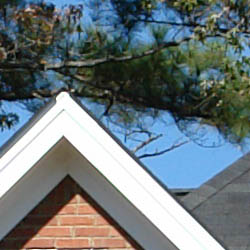
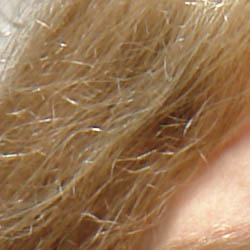
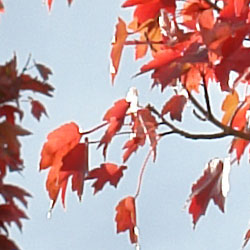
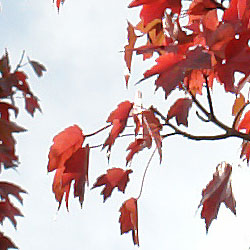


Follow Imaging Resource: